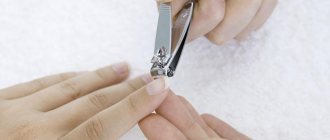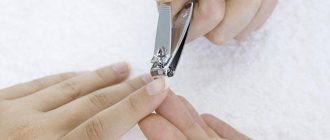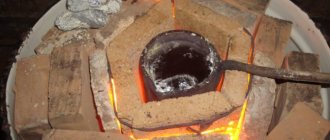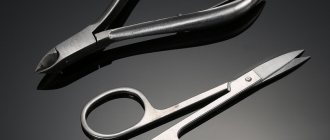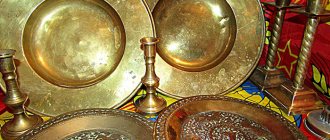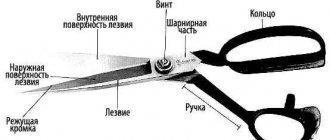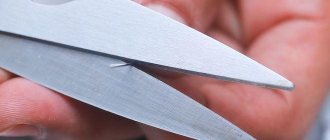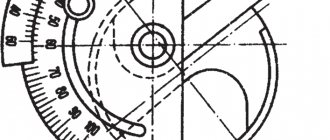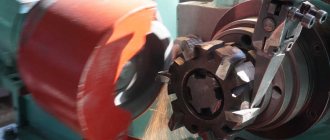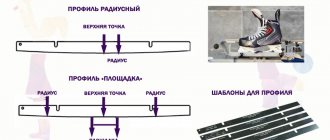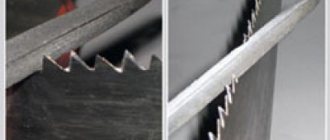Choosing and purchasing a manicure tool is only half the battle, since it requires constant and high-quality maintenance and sharpening. New scissors or forceps can become dull after just a few uses, and some need to be brought into good working condition immediately after purchase. It all depends on the quality of the metal and the initial characteristics of the tool. What does a manicurist need to know about sharpening manicure tools? Is it possible and how to sharpen nail scissors, tongs and cutters at home? How to evaluate and accept a job in the service? Let's look at all the questions in order.
Types of sharpening
There are two directions:
- Conveyor or factory processing
- Manual sharpening
The factory one is of lower quality and often the sharpness is lost after the first 10-15 uses. Even if the blades are initially very sharp, they dull much faster compared to manual processing. Also, the blades may have different sharpness along the length, which is why forceps or scissors tear the cuticle and leave burrs.
Sharpening by hand requires experience, knowledge and skill. It is better to contact a professional in the workshop to get the desired result. Many craftsmen try to sharpen scissors and pliers at home using improvised tools. Yes, perhaps the sharpness will be enough for a couple more procedures, but after that it is still lost, and the service technician has to do more work to eliminate the consequences of home sharpening.
Tool Features
To give a second life to your manicure set, you need to correctly classify it and determine the tools necessary for this. Thus, manual sharpening of nail clippers and tweezers is most often carried out using a needle file, since their cutting blades have a curved shape. If a backlash is formed when they are compressed, then the repair is also supplemented by adjusting the connecting bolt.
After sharpening, the master must polish the tool to smooth out the slightest irregularities and treat everything with a disinfectant.
What professional equipment is used for sharpening manicure tools?
Where can you sharpen nail scissors, tweezers, and cutters if you have given up on home experiments and decided to entrust the tools to a professional? There are special workshops that carry out maintenance of manicure equipment.
On average, the cost of such a procedure starts from 300 rubles, and varies depending on the city and country of residence. Many craftsmen in big cities complain that the cost of the service is almost comparable to the purchase of new tools, but this is only if you compare inventory of low and medium price categories. If you are working with high quality products, it is better not to take risks and contact a workshop.
There are two types of professional sharpening machines:
- Mechanical
- Laser
The first ones are equipped with a diamond-coated metal grinding wheel, which, when rotated, grinds down the edges of the tools, giving them the desired sharpness. The method keeps the tool durable and does not shorten the service life.
A laser machine is easier to use, but it wears down the metal faster, making it more fragile. Where to sharpen manicure tools after this? Of course, where the craftsman does it with a high level of quality, regardless of what machine is used.
How to extend the life of a manicure tool
↪ Professional sharpening of manicure instruments extends the life of the devices only if the masters follow a number of rules when using them:
- Do not remove material from the tool by knocking on hard surfaces. To do this, take a soft cloth and use gentle movements to clean the devices from hair, skin and nails.
- It is strictly prohibited to use boiling water to sterilize instruments. High temperatures negatively affect the condition of even the most durable metal. It is better to contact specialists who will sterilize the instrument at an affordable cost.
- The instrument should be stored in protective covers and cases. It is important to find a separate place for each device. Constant contact with each other will cause the cutting edge to become dull.
- Do not overuse disinfectant solutions and devices. This will lead to rapid wear of the cutting parts.
◼ After working with the tool, you should wash it thoroughly, dry it with a hairdryer and lubricate it with oil. Particular attention should be paid to oil treatment of all joints of the mechanism, because this is where hair, nails and other debris most often accumulate.
Basic rules for sharpening tools
There are several key points that make up the algorithm for servicing manicure equipment. If all points are completed, we get the desired result.
- When closing scissors, forceps or cutters, nothing should prevent the handles from coming together. If such a problem arises during work, they must be taken to the workshop and all interfering or protruding parts must be ground off on the machine. At home, you can do this with a sharpening stone or rasp, being careful.
- Nippers, cutters and scissors should not dangle, there should be no gap between the cutting planes and at the point of connection of the handles.
- The cutting planes of the nippers should be smooth and close without gaps under gentle pressure.
- The convergence of the cutting edges in the nippers should be uniform from one edge to the other, and not wavy: first the tip, and then the heel, or vice versa.
- The blades should not have protrusions or burrs that catch, scratch or cut the skin.
- The outer edge of the pusher should be sharper than the inner one, and the inner one should have a straight line without jagged edges. The main task of the tool is to move the skin, not cut it.
When sharpening, all factors must be met to obtain the desired result.
Sharpening of pliers, skin tongs, tweezers. If the cutters are loose, they are stuffed at the junction of the blades. They should walk softly and close in an even line. The inside of the nippers is ground down to a straight line from the inside. When closing, the blades should be in the same plane, neither higher nor lower than one another. If there are burrs on the tips of the cutters, they need to be sanded down.
Nippers for manicure and pedicure - types, brands, selection criteria and operating rules
Sharpening pushers.
After processing, they should be sharp, but not cut the skin. They should also not scratch the nail. If the pusher falls and bends, the edge is leveled and then ground down. The pusher is always sharpened on the outside, and only polished on the inside. It is necessary to ensure that the outer edges are not sharp; they should also be ground and sanded.
Types of pushers - comparison, characteristics, operating rules
Sharpening nail scissors.
If the blades were deformed after a fall, the edge will have to be ground down. If the damage is significant, then most often the scissors cannot be repaired. If the deformation is small, then grinding helps eliminate it, but the length of the blades will be reduced.
When sharpening scissors, only the front surface is removed. You cannot go into the rear one; it was processed only once at the factory, and this is enough for the entire operating cycle. After each grinding of a layer, it is necessary to remove the metal grain from the blades so as not to damage them when closing.
Nail scissors - types, proper use, choosing the best
The sharpening angle of the scissors must correspond to the factory rake angle and cannot be changed. Usually it is 60-75°.
At the final stage, it is recommended to go over the blades with fine-grained sandpaper to remove burrs.
Sharpening manicure knives.
They are used mainly for pedicures, to remove rough skin and corns. The manicure knife should not be very sharp; the factory angle should be maintained and the edge should not be ground into a bayonet.
Part of the article on sharpening manicure tools has moved to the page https://www.absolutzatochka.ru/ru/sharpening_manicure_tool
1. Many even new nippers have play in the joint. A competent craftsman must first correct this play, otherwise it is simply impossible to achieve the correct alignment of the cutting parts of the tool.
The second very important point is that nail clippers are very sensitive to falls. After such blows, their noses become dull and bent, so that they have to be restored, and sometimes new ones must be formed. This is a very labor-intensive and painstaking process. But specialists who sharpen manicure tools know how important it is for nail technicians, and know a wide variety of high-quality techniques for restoring it.
2. Unlike hairdressing salons, sharpening nail scissors also has its own characteristics. Frequently occurring damage is dull cutting edges and internal surfaces, due to the fact that scissors were used not only to trim cuticles, but also nails. In such cases, the master has to completely restore the blade, noses and carefully polish them to restore their previous cutting properties.
3. The most difficult moment when sharpening manicure tweezers is to achieve complete convergence of the jaws of the tongs along the entire length, otherwise during work the cuticle will simply slip out (or tear).
4. A simpler, but no less responsible procedure is sharpening pushers and blades . Here the main role is played by polishing and giving the instrument the correct shape.
These nuances and subtleties cannot be studied in any institute or technical school. All masters of sharpening manicure tools gain their experience only through practical means. And when there are tens of kilograms of sharpened iron behind him, the sharpener becomes a real professional, capable of understanding the client and doing exactly what he needs - efficiently and quickly.
Tool sharpening for manicurists and pedicurists.
Sharpening manicure scissors , nail scissors, cuticle scissors, cuticle scissors, sharpening skin scissors.
This group includes only three types of scissors:
- nail scissors
- leather scissors
- universal scissors for skin and nails
Sharpening scissors is more difficult with universal scissors.
This combines two different rules for sharpening. On the lower cavity of the blade for nails, on the upper cavity for skin.
Sharpening nail clippers
Nail clippers are a manicure tool that nail technicians use on both skin and nails. We divided these concepts into tweezers and nippers. In general, there is no such expression as tweezers, this word is unknown to the Russian dictionary; There are tongs, but they are no longer nippers. So, in the world of manicure, well, at least among sharpeners, nippers are a tool used for nails, while tweezers are a tool for skin and cuticles.
Sharpening nail clippers
Sharpening of nail clippers from the inside of the blade is done manually using diamond (a special coated abrasive); the clippers themselves are less finicky than tweezers. After initial processing and sharpening, the nail clippers are brought to a shine and an easy cut using a special tool. equipment using polishing paste.
Sharpening cuticle nippers
Cuticle nippers are truly the key tool for trimming manicures. Not a single cuticle trimming procedure is complete without them. Cuticle nippers come in different sizes, but all of these tools have one thing in common - helping to get rid of overgrown skin. The quality of a manicure using nail clippers depends on the hardness of the metal used and the quality of sharpening. The most difficult task in sharpening is to achieve 100% convergence of the jaws of the cuticle nippers completely. If the edges are uneven, the cuticle cutters will either be unable to grasp the cuticles or will tear them altogether. There are two options for processing the finished tool: factory and manual. Hand sharpening is significantly superior to factory sharpening if it is done by a fan of his craft.
Sharpening nail clippers
Sharpening manicure tweezers in itself is primarily beneficial to the manicurist, because ask yourself an interesting question: what can you use instead of tweezers? The main thing here is convenience and comfort of work, well, money matters, since you can buy tweezers for at least 450 rubles, and it’s not a fact that they will be professionally sharpened. You don’t plan, I suppose, to buy cheap nail clippers every day like this 7. When sharpening, nail clippers go through many operations and then cleanly cut off the cuticle with a light touch! The sharpening lasts for quite a long time so you can work quickly without damaging the cuticle and have fun! For more information on sharpening tweezers, see the article here
Professional hairdressing scissors are subject to quality control during their production; this quality control is called “laser”. This is by no means laser sharpening , but only checking the sharpening angle and the tightness of the blades. Read more: sharpening hairdressing and manicure tools
Sharpening tweezers
The correct sharpening of tweezers is that the tweezers pluck, and do not tear the hair or cut it in half, the tweezers should pluck the hair from the root; the tweezer blades on both sides will be smooth, without any roughness. The polished tweezers thus ensure smoothness and do not leave scratches when working on the face and skin. These are fundamentally important aspects of tweezers for any cosmetologist. See further: About sharpening
sharpening of nippers, sharpening of manicure nippers, sharpening of manicure nippers, sharpening of cuticle nippers, Moscow, in, Moscow
How and with what to check the sharpening level
Even a professional manicure cannot be done with a blunt instrument. That is why regular maintenance of tongs, scissors, and tweezers is necessary. With a large flow of clients in the salon, maintenance of scissors and cutters may be required once every two to three weeks. With a lower flow - much less often.
To understand when it's time to sharpen your manicure tools, there are a number of simple tests. They will require the following materials to choose from:
- Thin plastic bag
- Stretch film
- Dried wet wipe made of non-woven material
- Elastic vinyl, latex or nitrile gloves
These same tests will allow you to check the quality of the work performed by the master. In the workshop, these tests are used to check each of the processing stages of blades and cutting edges.
Methods and instructions on how to check the quality and level of sharpening:
- We fix the thin plastic bag so that the edge is even. Unclench the scissors, tongs or wire cutters, place the edge of the bag between them, and close along the entire length. The blades should not tear, snag or pull the polyethylene.
- Stretch film is the most demanding material for checking the level of sharpening. The principle is the same - we fix the film and close the blades along its entire length. The cut should be smooth.
- A napkin made of non-woven material demonstrates well the presence of burrs on metal. With high-quality processing, the cut is smooth, without snagging on the blade.
- Vinyl or nitrile gloves should be secured between the thumb and forefinger, the cutting edges should be completely opened and closed, placing the glove sheet between the blades, and then pulled down slightly towards you. Often scissors or tongs cut well at the base, but the closed edge pulls the glove and tears it. This means it's time to sharpen the blades again.
Work from real professionals
The Sharpening Center in Moscow knows what high-quality tool sharpening Highly qualified specialists with many years of experience work here. They use modern equipment that allows them to perform work at the highest level.
▶ Timely sharpening of manicure tools is the key to a successful and impeccable manicure. Poor quality equipment will not only not lead the technician to the desired result, but can also cause various infections and diseases.
☀ Before starting sharpening, our craftsmen thoroughly clean and eliminate all unevenness of the cutting parts, and after work, be sure to lubricate all handle joints.
✔ Our studio offers affordable prices :
- sharpening of manicure tweezers - 150 rub.
- sharpening scissors - 250 rub.
- sharpening tweezers - 150 rub.
- sharpening of nail clippers - 250 rub.
- sharpening of hairdressing scissors - from 250 to 300 rubles.
✌ We guarantee high quality affordable prices
Proper sharpening of manicure tools at home
How to sharpen manicure tweezers, scissors and nippers at home? This can be done at home using a grinding wheel or by hand. If you don't have experience with this, it's better to ask someone who has tried it or knows how to do it. Otherwise, you need to take the manicure tools to the workshop.
If you still decide to carry out the procedure at home, you will need:
- Sharpening stone or rasp
- Sandpaper, hard and sanding
- Any of the above materials to check the level of sharpening
A block or rasp is suitable for processing large areas. They should work smoothly, respecting the factory angles. Next, the blades are sanded with sandpaper. It can be secured with tape to the handle of a spoon or a wide nail file for additional support.
You can get by with just sandpaper, first 600 grit and then 1500 grit, to smooth out any burrs on the metal.
Some craftsmen use foil folded in 4-8 layers, finely cutting it with a tool to the desired degree of sharpening. Reviews about this method are mixed, so if you have an expensive, high-quality instrument, it’s better not to risk it.
Everyone should mind their own business, and if possible, it is better to have the tools serviced by a professional. If you decide to do the treatment at home, follow all recommendations.
Our offers
The company's craftsmen will professionally sharpen :
- Knives: kitchen knives of all types - ceramic, steel, household (household), professional, graders (with a sawtooth or wavy cutting edge), for cleaning and cutting vegetables, meat, bread, slicers,
- from a hair clipper,
- hunting, folding,
- unique,
- "guillotines";
- for blender and meat grinder,
- for overlock;
- for surface planer;
The work is performed in front of customers. If you don’t have time, a company employee will come and pick up the tools and then deliver them back. Delivery is carried out within the Moscow Ring Road from 4,000 rubles, the order amount is free.
We also invite everyone to take a course on high-quality sharpening of any knife products, household and professional tools. Upon completion of the studies, a certificate is issued and assistance is provided in selecting the necessary equipment for independent activities.
